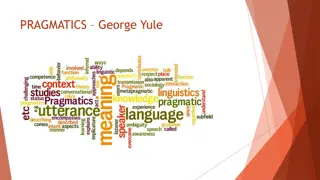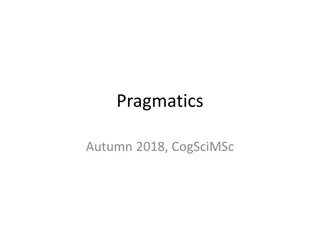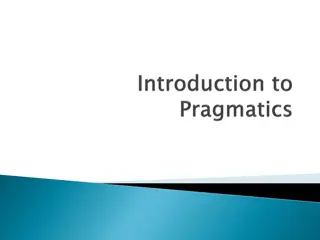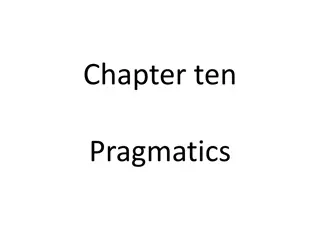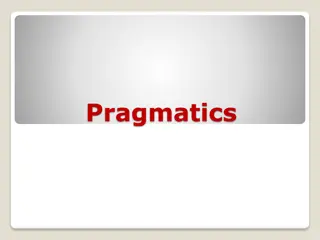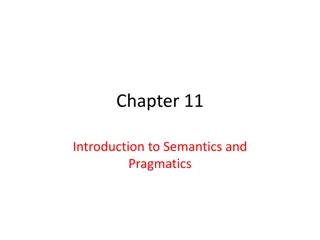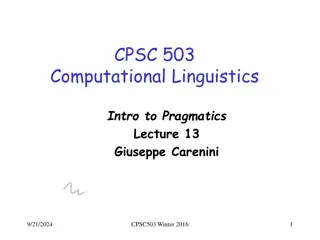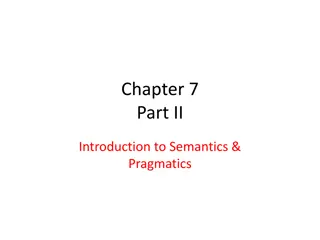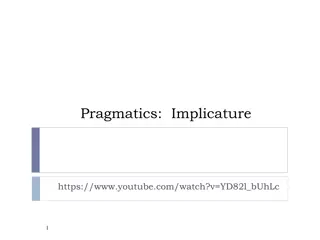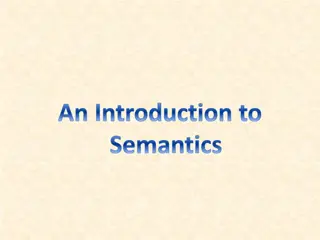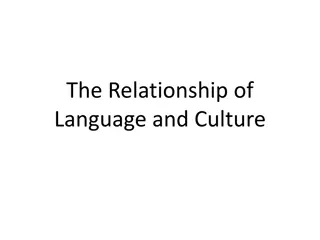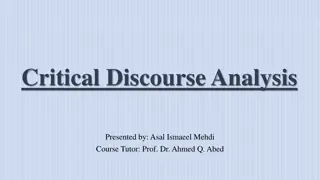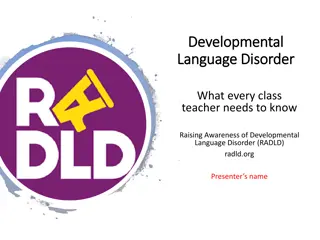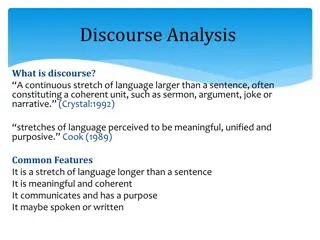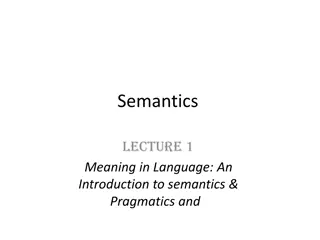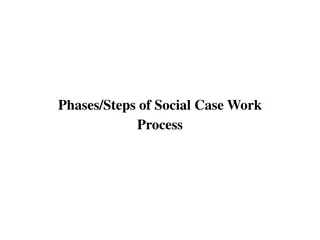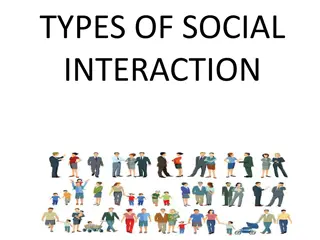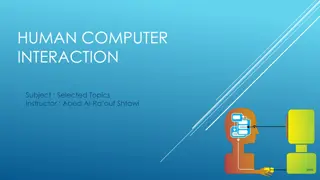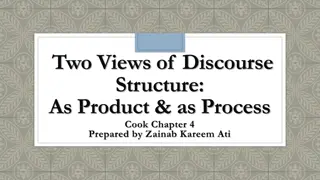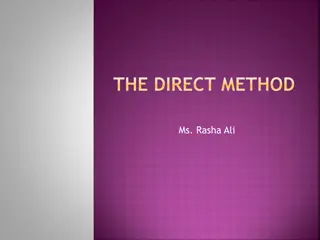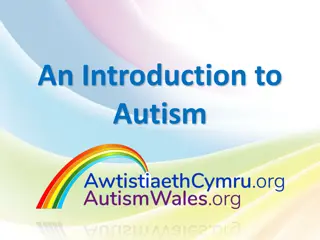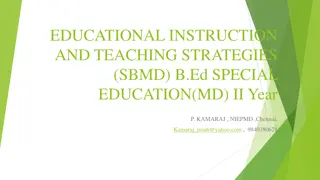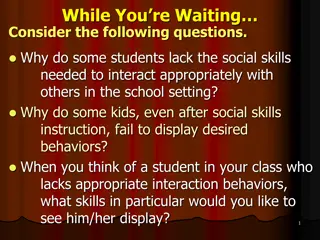Understanding Pragmatics: The Study of Language in Social Interaction
Pragmatics, a subfield of linguistics, focuses on the factors influencing language choice in social contexts. It differentiates between semantic and pragmatic information, emphasizing the relationship between language use, context, and the effects on communication. The study of pragmatics delves into speaker's meaning, contextual meaning, communication beyond words, and expression of relative distance.
Download Presentation

Please find below an Image/Link to download the presentation.
The content on the website is provided AS IS for your information and personal use only. It may not be sold, licensed, or shared on other websites without obtaining consent from the author. Download presentation by click this link. If you encounter any issues during the download, it is possible that the publisher has removed the file from their server.
E N D
Presentation Transcript
SEMANTICS AND PRAGMATICS Bach 2004. Semantic information is information encoded in what is uttered these are stable linguistic features of the sentence. Pragmatic information is (extralinguistic) information that arises from an actual act of utterance, and is relevant to the hearer's determination of what the speaker is communicating.
Whereas semantic information is encoded in what is uttered, pragmatic information is generated by, or at least made relevant by, the act of uttering it. Pragmatics attempts to relate meanings to context of utterance; it views language as action which is performed by speakers.
DEFINITION Pragmatics studies the factors that govern our choice of language in social interaction and the effects of our choice on others. (David Crystal) The Oxford Companion to Philosophy (Fotion 1995). Pragmatics is the study of language which focuses attention on the users and the context of language use rather than on reference, truth, or grammar
HISTORY OF PRAGMATICS The term pragmatics was first coined in the 1930s by the philosopher C.W. Morris; developed as a subfield of linguistics in the 1970s. Pragmatics studies the factors that govern our choice of language in social interaction and the effects of our choice on others. (David Crystal)
Pragmatics is concerned within 4 areas 1. It s a study of speaker s meaning 2. It s a study of contextual meaning 3. It s a study of how more gets communicated than is said 4. It s a study of the expression of relative distance
Its a study of speakers meaning Communicated by a speaker/writer the analysis of meaning by their utterances Interpreted by a listener U know what? You re beautiful
Its a study of contextual meaning How the context influences what is said Consider: Who we re talking to, where, when and under what circumstances
Its a study of how it is communicated morethan is said How the listener recognized the invisible meaning (the untold ones) Listener makes inferences of what speaker said E.g: satire expression idiom expression
Its a study of the expression of relative distance the choice between the said and the unsaid DISTANCE CLOSENESS How close/distant the listener is, speakers determine how much needs to be said Physical, social, conceptual Implies shared experiences
fundamental cornerstones of pragmatic inquiry The points are (1) Communication involves complex intentions. (2) These communicative intentions have to be inferred. (3) Communication is governed by principles/maxims.
Pragmatics involve three major communication skills: 1. Using language for different purposes, such as greeting (e.g., hello, goodbye) informing (e.g., I'm going to get a cookie) demanding (e.g., Give me a cookie) promising (e.g., I'm going to get you a cookie) requesting (e.g., I would like a cookie, please)
2 Changing language according to the needs of a listener or situation, such as talking differently to a baby than to an adult giving background information to an unfamiliar listener speaking differently in a classroom than on a playground. 3. Following rules for conversations and storytelling, such as taking turns in conversation introducing topics of conversation staying on topic rephrasing when misunderstood how to use verbal and nonverbal signals how close to stand to someone when speaking how to use facial expressions and eye contact
Types of Contexts pragmatics is the study of the contribution of context to meaning. Context of an utterance consists of- speaker, the sentence which is uttered, the act performed in the uttering of sentence, and the hearer. In pragmatics four types of context can be differentiated: physical context, epistemic context, linguistic context and social context
Physical context: The physical context is the location of a given word, the situation in which it is used, as well as timing, all of which aid proper understating of the words Epistemic context: the epistemic context refers to what speakers know about the world. For example, what background knowledge is shared by the speakers is part of your epistemic knowledge Linguistic context: the linguistic context refers to what has been said already in the utterance Social context: the social context refers to the social relationship among speakers and hearers.
Speech Act To speak = to act A sentence is uttered by a speaker, and when the speaker utters it he/she performs an act. This is called a speech act. Meaning in this sense involves the speaker s intention to convey a certain meaning which may not be evident in the message itself. For example in sentence There is a fly in my soup speaker s intention may be to complain. So the meaning of the utterance contain the meaning of the complaint.
A hearer may interpret it not just as a statement but as a Request to take the soup away. That is, the meaning will include certain intended effect on the hearer.
Grices Cooperative Principle All communication takes place in a situation where people are co-operative. When people communicate they assume that other person will be co-operative and they themselves wish to co-operate. Under this principle following maxims are followed: Maxim of Quantity: Give the right amount of information, neither less nor more than what is required. Maxim of Quality: Be true, do not say what you know is false or for which you do not have adequate evidence
Maxim of Relation: Be relevant. Maxim of Manner: Avoid obscurity and ambiguity; be brief and orderly. Whenever any or all of these maxims are violated implicature is generated. For example in the interaction: A: Where is my box of chocolates? B: The children were in your room this morning. Here maxim of relation is flouted which implies that B does not know the answer and also implies a suggestion on B s part that the children may have taken the chocolates.
Visiting relatives can be boring.



